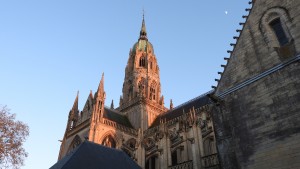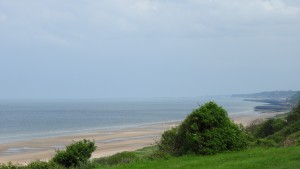With six years of French language classes under my belt and a general interest in modern French history, I was most excited for our program’s stop in France. Despite my Francophile tendencies, I was still a little nervous about my first visit to the country. Would it live up to my expectations?
Fortunately for me, my stay in Normandy did not disappoint.
After traveling from London to Portsmouth and taking a ferry across the English Channel, our group arrived in Normandy and took a bus to the small Norman town of Bayeux, where we stayed over the following six days. On our final day there, Professor Steigerwald referred to our time in Bayeux as being in “fairytale land,” and in fact, this is probably the most apt way to describe it. Bayeux is a small, quiet town surrounded by scenic countryside and rolling hills. It was a welcome reprieve from the fast-paced hustle and bustle of London, and, in some ways, reminded me of my own hometown in rural Ohio. That being said, it was still unlike anything I had ever seen or experienced in the United States.
Most communities in Europe can be dated back not hundreds, but thousands of years. In the United States, where everything is relatively new, a building over a hundred years old easily qualifies as
“old.” In Europe, however, such aged buildings are the norm. I commented in my last post on the amount of history to be found in the city of London. Bayeux was more than just a town full of history. Entering the town itself felt like stepping into another time: many of the buildings appeared to be hundreds of years old, and lots of streets were still paved with brick and cobblestone. At the center of the town was a cathedral nearly a thousand years old, built in the time of William the Conqueror. Fortunately, during the Battle of Normandy in 1944, German forces occupying the town fled without putting up much of a fight, sparing the town from the destruction rained down on so many other Norman cities and villages during World War II.
Aside from the location itself, another aspect of Normandy that I was attentive to was the local people themselves. On the whole, my observations were unsurprising. The French have a certain “joie de vivre” about them that is much more evident than in Britain or the United States: they enjoy relaxing, socializing, and eating great food.
Some observations I made in Bayeux (and now in Paris as well) were a little more startling for me, however. The French are often stereotyped as being unkept, and while I can’t attest to the personal habits of the locals in Bayeux, one thing that took me aback was my encounters on the sidewalks (even right outside our hotel) with les crottes de chien: dog feces. I don’t know if there are any particular laws in France demanding owners clean up after their dogs, but if they exist, many French dog owners seem to pay no attention.
Putting such peculiarities aside, most interesting for me was observing how the locals reacted to us Americans. Despite our own stereotypes of the French as snobbish and inherently anti-American, most of my interactions with the locals in Normandy were positive. When an interaction was negative, it seemed to be out of their annoyance with us more than anything else, and the locals certainly had reasons to be annoyed. I noticed that the French are a generally quiet people who keep to themselves in public. When it comes to Americans, on the other hand, this is not so much the case. Walking through the streets of Bayeux, our large, rambunctious group attracted more than a few stares, and some of us were told occasionally to quiet down. While taking a shuttle bus to Mont Saint-Michel, it was quite obvious that many of the French passengers (and especially the older ones) were not happy to have a group of American students crowding onboard and pushing them aside.
Most of my interactions with the locals took place around food (either at the grocery store or at restaurants and cafés), and while almost all of these were positive, there was one instance on our first evening in Bayeux (during a group dinner) that one of our servers commented on our poor dining etiquette. Some of us had been picking apart our food, and the server laughed and told us we “ate like birds.”
In writing about my experiences in Normandy, of course, it would be impossible for me to go without mentioning the 1944 invasion of Normandy during World War II and my visits to the various battle sites, museums, and cemeteries associated with the war. Visiting the Utah and Omaha landing beaches were especially poignant moments. Bloodshed and carnage immediately come to mind when thinking about the D-Day landing beaches (thanks, no doubt, to films like Saving Private Ryan), which is why I was immediately struck by the serenity and beauty of these places today. After viewing them

A French father and son at the Airborne Museum. I was surprised at the large number of French tourists visiting sites dedicated solely to the American war effort
firsthand, it’s difficult to think of these beaches as former battlegrounds, much less as battlegrounds where thousands of American troops took their last steps. The only word I could use to describe my feelings being there is “surreal,” and even now, I don’t think the full immensity of the events that took place there over seventy years ago has sunken in.
Particularly moving for me was the French and their reactions to the war today. Despite being stereotyped as anti-American, and despite the few negative interactions I personally experienced, the French (at least in Normandy) have certainly not forgotten the efforts of American, British, and Canadian forces to liberate their country from Nazi occupation. Aside from the cheesy signs at tourist sites reading “Welcome, our liberators,” it was clear to me that many local Frenchmen still remember and appreciate what happened in Normandy over seventy years ago. Many museums dedicated to the memory of the American war effort (like the museum at Utah Beach) are maintained by French staff, and I was touched reading the comments in a guest book (nearly all of them written in French) at the Airborne Museum, praising the museum and highlighting the need to preserve the memory of D-Day for future generations of Frenchmen.

“We have not forgotten, we will never forget, the debt of infinite gratitude that we have contracted with those who gave everything for our liberation.” – French President René Coty
Some program members were bothered by the swarms of French schoolchildren taking fieldtrips to the sites (there were several busloads of them when we visited Pointe du Hoc), as well as the lack of respect that many of them seemed to display. While, to be fair, most of these schoolkids were too young to fully understand the importance of the places they were at, I thought their very presence said a lot about the French. The fact that schools continue to send their students on fieldtrips to war sites in Normandy highlights the importance that the French attach to the Allied invasion in their national history. The effort to preserve the memory of D-Day for future generations is alive and well in France. At the American Cemetery in Colleville-sur-Mer, a fitting quote from French President René Coty was inscribed on a wall outside the visitor center, summing up my observations of the French in Normandy: “We have not forgotten, we will never forget.”




